#construction programs in philadelphia
Text
What Types of Construction Training Offer The Best Learning Opportunities?
Several construction training opportunities offer the best learning experience. Learn the best ways to learn construction work.
#construction training programs in philadelphia#construction institute in philadelphia#construction trade schools degree in philadelphia#construction courses in philadelphia#construction training programs in Mantua#construction training program in philadelphia#construction programs in philadelphia#best construction institute in philadelphia#construction certification institute in philadelphia#trade schools for construction in Overbook Park#certification construction in philadelphia
0 notes
Text
How Does Construction Training Benefit High Schoolers?
Construction training plays an essential role in the economic growth of high schoolers. Dive in to learn the importance of construction training programs.
#construction training in Cinnaminson NJ#construction program in Cinnaminson NJ#construction training programs in Cinnaminson NJ#trade schools for construction in Cinnaminson NJ#construction course in Cinnaminson NJ#masonry classes in Cinnaminson NJ#construction certification institute in philadelphia#construction school in philadelphia#construction programs in philadelphia#construction tech institute in philadelphia
0 notes
Text
Average Pacific Rim Headcanons
A local ice cream place offers kaiju blue milkshakes for sale (berry flavored with lime). A sign says that percentage of the profits are donated to kaiju blue poisoning treatment research.
If you were in school and lived in a coastal Pacific city during the kaiju war, you had kaiju escape drills.
You had PPDC officials come to your school looking for drift compatible students.
You know a girl who claims that she can channel the kaiju. She has a small online following who hang on to her every word.
Construction projects are delayed or halted in your city as iron is redirected to the jaeger program.
Anytime you and your friends say something at the same time, you joke about being drift compatible. Part of you hopes you really are.
If you were in college, you considered changing your major to biology or engineering, if it wasn't that already.
You follow several scientists researching kaiju or the breach on social media. Some work for the PPDC, some work for private labs or university labs. Some would host AME sessions. You watch as the scientists working for the PPDC all eventually announce that they've been let go and are going to work elsewhere now.
You follow several rangers on social media. One by one, they stop posting. Their deaths are announced on the news.
People joke about sending the citizens of Philadelphia to fight kaiju. They're so good at crushing invasive spotted lantern flies, they should be good at destroying kaiju.
Scientists announce the discovery of a bacteria that eats kaiju blue. Several more are eventually found all over the world.
622 notes
·
View notes
Text
NHLPA launches a new program to help players prepare for life outside of hockey
i.e. dad yelling at u to get a real job bc ur etsy shop aint be bumpin forever

the kids are getting a high school guidance counsellor and co-op term! what colour is ur parachute nursey

no wonder sabres on the rise oko's media hits so beautifully eloquent. they got smartypants mini gm at the helm
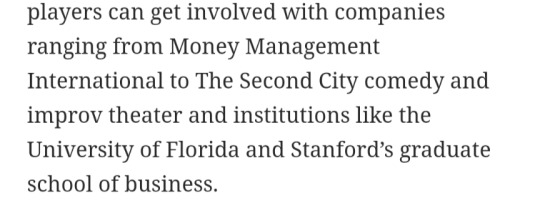
i just find this so interesting and wonderful ...and like if a big hockey butt wants to come hit me up for improv classes i'm not complaining🫠 imma make a union actor (nate. realistic) two time emmy winner (sid. dream on u don't have that ass) outta u
full article under cut:
Early in his time in the NHL, Darnell Nurse says he did not notice a lot of players talking about what to do after hockey. Going into his ninth season, the chatter is now normal.
“People are curious as to what there is outside the game and what you can do to prepare yourself,” Nurse said.
Plenty of players have taken it upon themselves to prepare for the future, like Zdeno Chara getting his real estate license and others finishing college degrees or exploring business opportunities. The NHL Players’ Association on Thursday launched a program that gives its members the chance to do a personality analysis and delve into real estate, business or other avenues while still in the league.
The hope is to help them develop interests outside of hockey while playing and ease the transition to life afterward.
“It’s something that’s been missing a little bit,” veteran center Lars Eller told The Associated Press. “It’s kind of well known that one of the struggles for a professional athlete is the transition on to the next thing once he’s done with his professional career. And this platform helps you with that transition, and it’s something you can start even while you’re still playing so you can sort of hit the ground running once you’re done.”
New union boss Marty Walsh made helping former players one of his top priorities. His arrival in March coincided with a process two years in the making, after player feedback indicated the desire for more assistance outside of hockey.
The result is the NHLPA UNLMT program. Retired defenseman-turned-psychologist Jay Harrison is available to do an assessment, and players can get involved with companies ranging from Money Management International to The Second City comedy and improv theater and institutions like the University of Florida and Stanford’s graduate school of business.
Former goaltender Rob Zepp, who’s spearheading the program as the union’s director of strategic initiatives, said an extensive survey provided the building blocks for something that was designed to be 1-on-1 and customized for players to figure out what might interest them.
“What we’ve seen so far it really runs the gamut: anything from enhancing one’s personal brand to starting a podcast to taking these certificate-level courses in real estate, in entrepreneurship, in business, in leadership, communication skills, networking skills,” Zepp said. “We have players that are interested in or are currently pursuing commercial real estate avenues or farming ventures or construction.”
Eller, Nurse and Buffalo captain Kyle Okposo are among the players who have tried UNLMT so far. Okposo has already graduated from Stanford’s business leadership program, while Eller has spoken with Harrison and taken some of the courses offered.
“They’re not waiting until people’s careers are over,” said Nurse, who is still in his prime at 28. “It’s something that you can dip your feet into and grab a hold of while you’re still playing and giving you resources and opportunities to kind of figure out what you want to do.”
Zepp got a degree from the University of Waterloo and an MBA from the University of Liverpool the old-school way — tapes and textbooks sent by mail and tests taken in front of a proctor — while playing mostly in the minors and Europe before before 10 games with Philadelphia in 2014-15. He felt like having something to study made him a better goalie and understood there was plenty of idle time on the road.
Eller, who is a silent partner involved with helping start-up businesses, thinks the same way.
“We, as players, we have — not a lot of freedom once the season is starting — but we do have a lot of free time,” said Eller, who scored the Stanley Cup-winning goal for Washington in 2018 and is a pending free agent at 34. “It’s a huge positive if you have something else that you can take your mind off of hockey and do something productive with that time.”
Walsh got to know several Bruins alumni when he was mayor of Boston and has since talked to other former players and come away with a mandate to protect guys beyond their time on the ice.
“When they played, they gave it their all, and a lot of them didn’t really have anything after that,” Walsh said. “They didn’t make big contracts. They really didn’t have a strong pension system. A lot of them, even going back further than that, lost stuff. We can’t let that happen again.”
#nhlpa#kyle okposo#darnell nurse#lars eller#edmonton oilers#colorado avalanche#buffalo sabres#zdeno chara#boston bruins#marty walsh#annieQ hockey thoughts
111 notes
·
View notes
Text

Everybody say hello to Gwendolyn Zoharah Simmons: activist, teacher, and researcher. Born in 1944 Memphis, Gwendolyn was the first generation in her family to attend college (Spelman, 1962). She credits her grandmother, Rhonda Bell Robinson, with having instilled in her the family's history and its reckoning with slavery, her own hardships growing up as a sharecropper, and how Mississippi was objectively the "worst of the worst" for Black people. Gwendolyn solemnly promised her grandmother that she would never go to Mississippi. (And don't even get her started on the epic confrontations with teachers and school officials about the "inappropriateness of her hair." Boy, it's sure nice that that sort of racial dress-code pettiness isn't a thing anymore, huh?)
In the 1960's, inspired by several Spelman professors (to include Howard Zinn), Gwendolyn actively and enthusiastically became involved in the SNCC against her family's wishes. She participated in sit-ins and endured several arrests, ultimately jeopardizing her Spelman scholarship. She helped prepare curricula for Freedom Schools and coordinated mock voter registrations, working under Bob Moses (see Lesson 112 in this series) and alongside James Forman and her fellow Spelman alum Ruby Doris Smith-Robinson (see Lesson 66). Eventually she came into the orbit of the Mississippi Freedom Democratic Party, and ultimately found herself taking over as director of the Mississippi Summer Project in 1964 when its previous director, Lester McKinney, had been picked up by Laurel police. She herself was arrested in Jackson following a march; being held, beaten and tortured for 15 days in a makeshift prison constructed on the county fairgrounds.
Gwendolyn later moved briefly to New York, and then to Atlanta where she worked on Julian Bond's state campaign (see Lesson 72). She continued to work with the local chapter of the SNCC, authoring a controversial position paper on Black Power that argued against expelling its white members. Around this time Gwendolyn also (unsurprisingly) found herself on the FBI's notorious Counterintelligence Program (COINTELPRO) target list.
Inspired by the speeches of Malcolm X, Gwendolyn joined Nation Of Islam in the late 1960's and changed her name to Zoharah (also taking her husband Michael Simmons' last name), and moved to Philadelphia. However her strong feminist principles contravened a number of NOI teachings, putting her at odds with the organization's stance on women as submissive helpmeets. Over the next 20 years she worked for the American Friends Service Committee, travelling to Jordan, Egypt, Syria, and (significantly) Palestine.
Gwendolyn retired from the University of Florida in 2019; conducting and leading research that explores Islamic feminism and the cultural impact of Sharia law on Muslim women. Today Simmons is senior lecturer emerita, continuing to travel and lecture on gender equality, and on many other issues affecting Black Americans, feminism, and social inequities. Her and Michael Simmons' daughter Aishah Shahidah Simmons, is herself an accomplished documentary filmmaker.
(Teachers: Need some resources to engage your students this Black History Month? I'll send you a pile of these trading cards, no cost, no obligation. Just give me a mailing address and let me know how many students in your class. No strings attached, no censorship, no secret-relaying-of-names to Abbott or DeSantis or HuckaSanders.)
#black lives matter#gwendolyn zoharah simmons#black history month#mississippi goddamn#spelman#sncc#nation of islam#feminism#teachtruth
9 notes
·
View notes
Text
New York City Culture🗽
New York City is frequently the setting for novels, movies, and television programs and has been described as the cultural capital of the world. In describing New York, author Tom Wolfe said, "Culture just seems to be in the air, like part of the weather."
The city is the birthplace of many cultural movements, including the Harlem Renaissance in literature and visual art; abstract expressionism (known as the New York School) in painting; and hip-hop, punk, hardcore, salsa, freestyle, Tin Pan Alley, certain forms of jazz, and (along with Philadelphia) disco in music. New York City has been considered the dance capital of the world.
One of the most common traits attributed to New York City is its fast pace, which spawned the term New York minute. Journalist Walt Whitman characterized New York's streets as being traversed by "hurrying, feverish, electric crowds". New York City's residents are prominently known for their resilience historically, and more recently related to their management of the impacts of the September 11 terrorist attacks and the COVID-19 pandemic. New York was voted the world's most resilient city in 2021 and 2022 per Time Out's global poll of urban residents.
Theater🎭
The central hub of the American theater scene is Manhattan, with its divisions of Broadway, off-Broadway, and off-off-Broadway. Many movie and television stars have gotten their big break working in New York productions.
Broadway theatre is one of the premier forms of English-language theatre in the world, named after Broadway, the major thoroughfare that crosses Times Square, sometimes referred to as "The Great White Way".
Forty-one venues mostly in Midtown Manhattan's Theatre District, each with at least 500 seats, are classified as Broadway theatres. The 2018–19 Broadway theatre season set records with total attendance of 14.8 million and gross revenue of $1.83 billion Recovering from closures forced by the COVID-19 pandemic, 2022-23 revenues rebounded to $1.58 billion with total attendance of 12.3 million.
The Tony Awards recognizes excellence in live Broadway theatre and are presented at an annual ceremony in Manhattan. The awards are given for Broadway productions and performances at the 41 eligible Broadway venues. One is also given for regional theatre. Several discretionary non-competitive awards are given as well, including a Special Tony Award, the Tony Honors for Excellence in Theatre, and the Isabelle Stevenson Award.

Architecture
New York has architecturally noteworthy buildings in a wide range of styles and from distinct time periods, from the Dutch Colonial Pieter Claesen Wyckoff House in Brooklyn, the oldest section of which dates to 1656, to the modern One World Trade Center, the skyscraper at Ground Zero in Lower Manhattan and the most expensive office tower in the world by construction cost.
Manhattan's skyline, with its many skyscrapers, is universally recognized, and the city has been home to several of the tallest buildings in the world. As of 2019, New York City had 6,455 high-rise buildings, the third most in the world after Hong Kong and Seoul.
The character of New York's large residential districts is often defined by the elegant brownstone rowhouses and townhouses and shabby tenements that were built during a period of rapid expansion from 1870 to 1930. Stone and brick became the city's building materials of choice after the construction of wood-frame houses was limited in the aftermath of the Great Fire of 1835.
In contrast, New York City also has neighborhoods that are less densely populated and feature free-standing dwellings. In neighborhoods such as Riverdale (in the Bronx), Ditmas Park (in Brooklyn), and Douglaston (in Queens), large single-family homes are common in various architectural styles such as Tudor Revival and Victorian.
Arts🩰
Lincoln Center for the Performing Arts, anchoring Lincoln Square on the Upper West Side of Manhattan, is home to numerous influential arts organizations, including the Metropolitan Opera, New York City Opera, New York Philharmonic, and New York City Ballet, as well as the Vivian Beaumont Theater, the Juilliard School, Jazz at Lincoln Center, and Alice Tully Hall. The Lee Strasberg Theatre and Film Institute is in Union Square, and Tisch School of the Arts is based at New York University, while Central Park SummerStage presents free music concerts in Central Park.
New York City has more than 2,000 arts and cultural organizations and more than 500 art galleries. The city government funds the arts with a larger annual budget than the National Endowment for the Arts. The city is also home to hundreds of cultural institutions and historic sites. Museum Mile is the name for a section of Fifth Avenue running from 82nd to 105th streets on the Upper East Side of Manhattan, in the upper portion of Carnegie Hill.
Nine museums occupy the length of this section of Fifth Avenue, making it one of the densest displays of culture in the world. Its art museums include the Guggenheim, Metropolitan Museum of Art, Neue Galerie New York, and The Africa Center. In addition to other programming, the museums collaborate for the annual Museum Mile Festival, held each year in June, to promote the museums and increase visitation. Many of the world's most lucrative art auctions are held in New York City.
The Metropolitan Museum of Art is the largest art museum in the Americas. In 2022, it welcomed 3.2 million visitors, ranking it the third most visited U.S. museum, and eighth on the list of most-visited art museums in the world. Its permanent collection contains more than two million works, divided among 17 curatorial departments, and includes works of art from classical antiquity and ancient Egypt; paintings and sculptures from nearly all the European masters; and an extensive collection of American and modern art. The Met maintains extensive holdings of African, Asian, Oceanian, Byzantine, and Islamic art.
Fashion🛍️
New York has frequently been ranked the top fashion capital of the world on the annual list compiled by the Global Language Monitor. New York Fashion Week (NYFW) is a high-profile semiannual event featuring models displaying the latest wardrobes created by prominent fashion designers worldwide in advance of these fashions proceeding to the retail marketplace.
NYFW sets the tone for the global fashion industry. New York's fashion district encompasses roughly 30 city blocks in Midtown Manhattan, clustered around a stretch of Seventh Avenue nicknamed Fashion Avenue. New York's fashion calendar also includes Couture Fashion Week to showcase haute couture styles. The Met Gala is often described as "Fashion's biggest night".
Parades
New York City is well known for its street parades, the majority held in Manhattan. The primary orientation of the annual street parades is typically from north to south, marching along major avenues. The annual Macy's Thanksgiving Day Parade is the world's largest parade, beginning alongside Central Park and proceeding southward to the flagship Macy's Herald Square store; the parade is viewed on telecasts worldwide and draws millions of spectators in person. Other notable parades including the annual New York City St. Patrick's Day Parade in March, the NYC LGBT Pride March in June, the LGBT-inspired Greenwich Village Halloween Parade in October, and numerous parades commemorating the independence days of many nations. Ticker-tape parades celebrating championships won by sports teams as well as other accomplishments march northward along the Canyon of Heroes on Broadway from Bowling Green to City Hall Park in Lower Manhattan.
3 notes
·
View notes
Text
Magnetic Attraction

Wandering around Paseo del Prado in Madrid, on an area named as the Golden Triangle of Art with the vertices settled at the Prado Thyssen-Bornemisza Reina Sofía museums – furthermore can be found a singular smaller museum The Caixa Forum (in a literal translation a bank safe-box), designed by Herzog & de Meuron symbolically inaugurating the new millennium with grandiloquent aspirations at the Spanish capital.

Belonging to a banking company, also converted into an arts patronage foundation, that novel and emblematic museum’s building assumes the character of a bank safe-box in which those cultural investments are deposited, preserved as tax-exempt financial assets, and also being exposed to the public. Since the Renaissance and baroque the subjective high value of art-works began to be used for those purposes, also being increased and magnified by a competitive furore between capital cities as “attractive poles” for “finantial investors”.

Those attractive aspirations seem to be implicitly figured in the character of the building, both conceptually and materially, a magnet as its authors characterised it: “The CaixaForum is conceived as an urban magnet attracting not only art-lovers but all people of Madrid and from outside. The attraction will not only be CaixaForum’s cultural program, but also the building itself, insofar that its heavy mass, is detached from the ground in apparent defiance of the laws of gravity and, in a real sense, draws the visitors inside.”
Being sealed to the outside-world in all exhibition floors, also justified for avoiding natural lighting due to conservation requests of some art-works, the building merely opens fiscally and visually to the city respectively below and up: by the street level, where all that constructive mass rises up as if levitating, for sitting a discrete entry below; and on the rooftop, in the restaurant and cafeteria, opening to the panoramic views over the city.

The intended magnetic character of the building, starting at the street level and driving the visitors to the inside of that massive corps(e) –lodged and filling an ancient industrial building, like an embalmed corpse, of which only his bricks skin remains– by walking through a short but in-tense promenade, that leads to a cavernous public entrance and the following ascendance by those cinematic staircases as if levitating to the reception hall on the upper floor, are the subject and the focus of this short writing quest and of this photographic record.

Cinematic motion in space (and in spatial) representation
A century before, Marcel Duchamp presented one of his most emblematic paintings "Nude Descending a Staircase, No. 1" (1911) and the version “No.2” (1912).

Marcel Duchamp's Nude Descending a Staircase, No. 1" (1911) © Philadelphia Museum of Art
At that time Duchamp’s work was ridiculed for not fitting either into futurism or at cubism movements. Against a dark background the figure is represented by multiple triangles with hinges, trailed through a sequence of overlaid images like frozen in time (photograms / frames) transmitting the impression of the descending movement of a body, traversing a given space –a fragmentary representation of a staircase.

Marcel Duchamp's Nude Descending a Staircase (No. 2), 1912 © Philadelphia Museum of Art
On one hand appears to be a cubist representation with multi overlayed viewpoints, at the represented background space of action. On the other hand it re-presents a trailed figure with a vibrant combination of reflected lights and projected shadows emphasizes a futurist motion action. Despite those allusions, the alluded motion is not linear as in the futurism speedy representations but rather circular, as an elliptical motion on space over time –as well can be seen on the vertical accesses of the museum – more in accordance with an oriental conception of space-time that just was admitted in Western culture after Einstein’s theory of relativity (first proposed in 1905) with the refutation of an absolute linearity of space and time.

Eadweard Muybridge's Animal Locomotion: Plate 92 (Nude Woman Ascending Staircase), 1887 © Huxley-Parlour
Those Duchamp art-works seems also to be implicitly in line with the primordial photographic studies on locomotion behind the beginnings of cinema, still so far as in 19th Century, mainly with Eadweard Muybridge’s female nude motion study (Woman walking downstairs, 1887) or the Horse Racing (1887) considered the first movie ever, based on the zoetrope and praxinoscope animations, or as well with the wonderful works of Étienne-Jules Marey on cinematic movement of different animals including man.
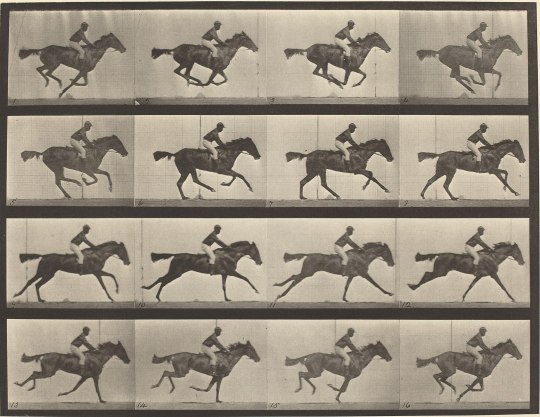
The Horse in Motion by Eadweard Muybridge show a sequential series of six to twelve "automatic electro-photographs" depicting the movement of a horse (1878).
Nearby Caixa Forum, crossing the great avenue just 500m away at Museo Nacional del Prado, can be found a major painting of Diego Velazquez, “Filipe IV, by horse” (1635), in which the horse's legs are represented with a sequence of faded frames alluding to motion in space-time, on that two-dimensional representation. Leonardo da Vinci on a commissioned project for an equestrian monument (1482) also produced a series of study sketches (1488-90) with a cinematic like representation of a horse, trough overlapping layers.
At Caixa Forum’s staircases not a simple person multiplies in mirror reflections while ascending or descending, as in the magnific Loos Haus staircases in Vienna (also completed in 1912 like the described Duchamp’s painting), but rather the stairs and surrounding walls de-composing materially in space (with multiple folds and angles) as well perceptually in the promenade’s time with a changing game between tangible matter (steps, and steel walls bent into triangles) and the given illusion by reflection of lights, shadows, and color nuances, while as/descending that staircase.
4 notes
·
View notes
Text
William Willis
William Willis was born in 1921 in Waco, Texas. His parents were affluent, college-educated African Americans. His father served first as an educator and then started a construction company. The family moved to Dallas when Willis was two "partly in response to an ultimatum from the Waco Klu Klux Klan" (Zumwalt 1). His father died a few years later and he was raised by his mother. Although he attended segregated schools, his family also traveled widely -- a habit he would keep up throughout his life.

William Willis from his Howard yearbook, via AmPhilSoc (as are all other images in this page)
Willis was a quiet, bookish child and went on to Howard University, where he graduate cum laude in 1942. It was there that he developed an interest in the sociology and history of the Black experience int he United States. Once out of school, he volunteered to join the Coast Guard and spent the war stationed in Boston. Afterwards, he decided to attend graduate school in anthropology at Columbia because he "assumed that this discipline was the vanguard in the attack against racist thought" (Zumwalt 2). He was thus in the same class of students as Eric Wolf, Marvin Harris, Morton Fried, Sydney Mintz, and Robert Murphy. He became interested in the history of Black and Indian relations, as wrote a dissertation based on library research on "colonial conflict and the Cherokee Indians, 1710-1760" and recieved his Ph.D. in 1955.
During his time at Columbia he married his life partner Georgine "Gene" Upshur, who came from a prominent African American family in Philadelphia. Her father was a Republican congressman in Pennsylvania's lower house and also, as it happened, the mortician who buried Bessie Smith, the great blues singer. She earned a BA in sociology and wanted to go on to study social work, but he father agreed to support her studies only if she also went to mortician school so that she would have a steady source of financial support. "People will always need an undertaker" he told her (Zumwalt 5). She was doing her masters in social work when she met Willis.

From 1955 to 1964 Willis tried unsuccessfully to pursue a career in anthropology. He applied to the Ford Foundation for a research grant and was turned down. He applied for teaching positions but was told by Duncan Strong (the department chair at Columbia) that no one would hire a black person. He and his wife lived in New York for nearly a decade and Willis published work while teaching part-time as a lecturer at Columbia and City College. In 1963 Willis's mother died of a heart attack and Willis and Gene decided to move back to Dallas to live in the family home.
Willis's luck turned on his return to Dallas. It was 1964, the high-water mark of the civil rights movement, and Southern Methodist University was looking to integrate its faculty. In 1965 he was hired to a position in anthropology. He was a tremendous success at the new institution, drawing large classes of students and helping to establish an MA and Ph.D. program in the department. He earned tenure and became a full professor. His wife became active in several local organizations -- at last, the Willis's were flourishing.
In the late 1960s, life again became difficult for Willis. His department chair, a racist, began harassing him -- this included actions like changing the locks on the office to his door and not giving him the key. Administrators above him supported his chair's behavior. Radical black politics came to campus, and militant student activists began making increasingly large demands on the administration. Willis -- a quite, reserved man who alway wore a bowtie in public -- found himself deeply sympathetic to the activists and became radicalized himself. As the only black professor on campus, he became a key player negotiating their relationship to the administration. It was in this context that he wrote his piece "Skeletons in the Anthropological Closet". He considered alternate titles for the essay, including "anthropologist as vulture" and "anthropologist as exploiter".

Willis at SMU, via APS
The Willises found it difficult to bear the brunt of the constant harassment they faced at SMU. Their health began to break down. Willis experienced constant pain in his abdomen and was afraid it was cancer -- in fact, it was stress. Gene began fainting in public. Willis decided to take a leave of absence in 1971 to recover. The administration then altered his request to make it a 'terminal leave of absence', making it sound as if he had resigned his position! Willis fought back against this attempt to remove him, but soon realized that if he stayed at SMU he would spend his entire life fighting the administration for his rights. When his leave of absence was over, he resigned from SMU. He had been there less than a decade.
Willis and Gene moved to Philadelphia, Gene's home town. They moved in with her mother and Gene's mortician experience ended up proving valuable, and the family business helped support both her and Willis. One of the upsides of the move was that the American Philosophical Society was based in Philly. Willis began his next and (as it turns out) final project there, combing through the massive archive of the Franz Boas paper. He became a fixture in the reading rooms of the society, well-known to the librarians and archivists who worked there. His initial plan was to write about the sort shrift Boas and his colleagues gave to Black Americans, but the more time he spent reading Boas, the more ambivalent he became. He came to see Boas as both an anti-racist activist and someone who at times seemed to harbor racist views of Black people.

Willis in the PBS Special "Shackles of Tradition" about Franz Boas. The entire documentary is on YouTube
Wilis began writing a book on the history of American anthropology's study of African Americans. Alas, this study was never to be finished. On 8 August 1983 Willis left the reading room, went home, and died of a massive heart attack. He was 62 years old. His papers are now in the APS library and his wife Gene has established a fund to support the study of race (APS Willis feature).
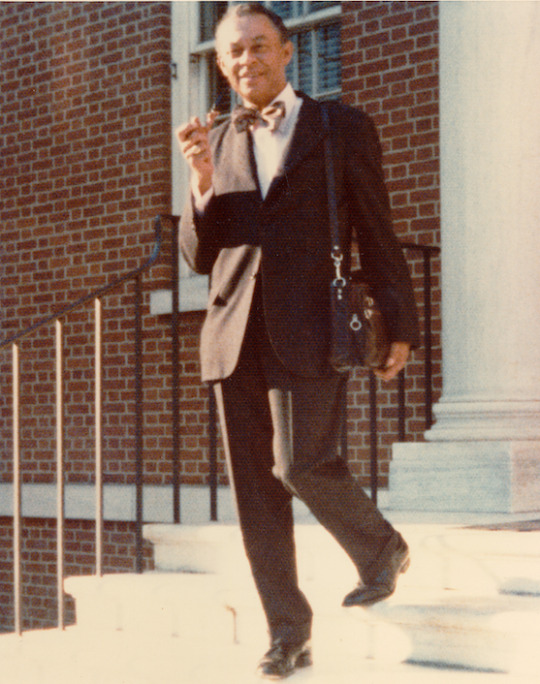
Via APS
Willis had little lasting influence on the discipline of anthropology. Although his "Skeletons" essay is now more widely taught, he did not train graduate students who could keep his memory alive. The first chapter of his book on Boas was published posthumously, but the rest of the work was already created. Today, Willis is remembered as a pioneer of African American anthropology but, to be honest, his biography shows us both the story of a model scholar and the tragedy of race in America.
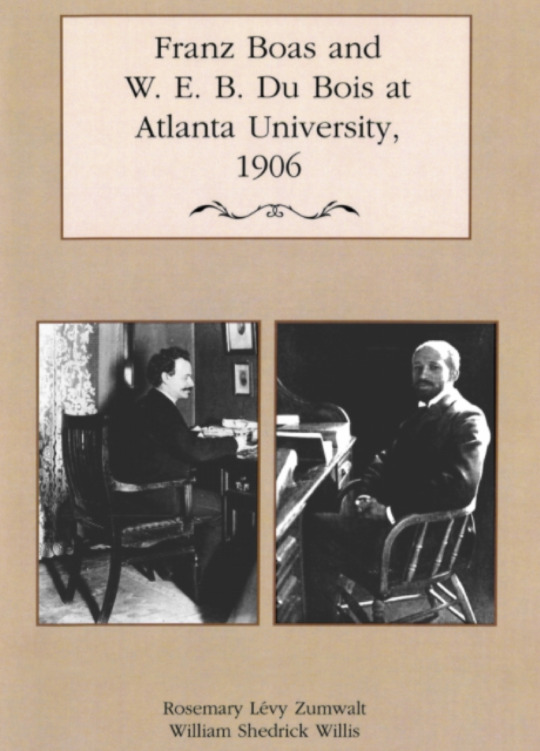
Willis's final volume is available on JSTOR.
52 notes
·
View notes
Photo

Frans Geffels - Dinner Party on a Terrace - 1660s
oil on canvas, 85.1 x 102.5 cm
Philadelphia Museum of Art, Pennsylvania, USA
Frans Geffels, known in Italy as Francesco Geffels (25 August 1624 – 18 February 1694) was a Flemish painter, printmaker, architect, stage designer and designer of ephemeral structures for solemn and festive occasions. After training in his native Antwerp, he was mainly active in Mantua, where he was prefetto delle fabbriche to the Duke, a role that gave him the direction of the artistic and construction activities undertaken by the Ducal court. He worked also on projects for the local aristocratic class of Mantua. In addition, he completed projects for the Liechtenstein princes and for the imperial court in Vienna.
He was both a canvas and fresco painter. He created portraits, history subjects, military scenes, architectural scenes and genre art, in particular merry companies. Geffels is mainly remembered as the designer of some of the key examples of Baroque architecture in Mantua.
He was born in Antwerp as the son of a laborer in a sugar refinery and a mother who operated a cheese shop. He trained in the guild year 1635/36 with Daniel Middeleer (also called Daniel Middeler and Daniël de Middelaer). Middeleer was a painter, printmaker and publisher. Geffels became a master in the local Guild of St. Luke some time between 18 September 1645 and 18 September 1646. By 1653 he was already abroad for some time.
He was likely recruited to work in Mantua in 1659, by his fellow Flemish painter and architect Daniel van den Dyck. Van den Dyck had been appointed by duke Carlo II Gonzaga, Duke of Mantua as the prefetto delle fabbriche ('Prefect of the Buildings'), a position which combined the duties of official court painter, architect, surveyor of the Ducal construction program and engineer for theatrical stage design.[8] Geffels was working as an architect at the court.
Geffens spent some time in Vienna in 1660-1661 where he worked for the Imperial Court. He returned to Mantua where he became, like van den Dyck before him, prefetto delle fabbriche of the duke of Mantua in 1663. He took the place of his compatriot van den Dyck had died in the previous year. In 1664 Geffens was granted citizenship of Mantua. He was described in official records as an artist who was skilled in creating devices for the theatre.
Geffels remained in the service of the Dukes of Mantua for 30 years. He worked in 1667 in Vienna on commissions for Karl Eusebius, Prince of Liechtenstein. There existed a close relationship between the Viennese court and the dukes of Mantua through marital links. The Empress Dowager Eleonora Gonzaga (1630–1686) was the third wife of Emperor Ferdinand III and the sister of Charles II Gonzaga, Duke of Nevers. He also participated on a book containing the libretto by Francesco Sbarra for the opera Il pomo d'oro scored by Antonio Cesti, which was staged twice in July 1668 on the occasion of the marriage of Emperor Leopold I and Margaret Theresa of Spain. The book was illustrated with prints depicting the various sets used during the staging of the opera. The folio de luxe edition of the book holds a print designed and etched by Geffels showing the opera's performance with Emperor Leopold I and his bride in attendance. The theatre in which the opera was staged had been purpose-built on the occasion of the couple's wedding after a design by Ludovico Ottavio Burnacini. The theatre was destroyed during the Turkish siege of Vienna in 1683 and Geffens' print now serves as the sole evidence of the interior layout of the theatre. In the print, the imperial family is shown sitting at the front. In the foreground there is a row of soldiers. Geffels had himself worked on the illusionist ceiling paintings for the court theatre, which are also shown in the print.
Even after his return to Mantua later in 1668, Geffels maintained contact with the Viennese court, as evidenced by his collaboration on the three-volume book by Gualdo Priorato with the title Historia di Leopoldo Cesare and also by his paintings depicting the Relief of Vienna in 1683 (Wien Museum Karlsplatz) and the Retaking of Buda in 1686 (Hungarian National Museum).
Geffens' official duties at the Mantua court included the design and execution of ephemeral objects and structures used on the occasion of important court-related events. In January 1666 he collaborated with Andrea Seghizzi on the decorations and objects made for the funeral of Duke Charles II Gonzaga, Duke of Nevers in the Basilica palatina di Santa Barbara in Mantua. When in 1776 Empress Claudia Felicitas of Austria died in Vienna not long after giving birth, her aunt Isabella Clara of Austria, Duchess of Mantua, had a funeral mass performed in the church of the Mothers of St. Ursula of Mantua, where the Duchess had become a Poor Clare nun. Frans Geffels was commissioned to design and construct a funeral monument that was set up in the middle of the church during the mass. It was mounted on four large marble-coloured pedestals, adorned on the top front with imperial eagles in low-relief. A print of the design was included in the book by Antonio Gobio and Geffels entitled Le essequie celebratesi nella chiesa delle MM. RR. Madri di S. Orsola di Mantoua: d'ordine della serenissima signora arciduchessa Isabella Clara d' Austria, duchessa di Mantoua, Monferrato, &c., per la morte dell' imperatrice augustissima Claudia Felice lei nipote published in Mantua in 1676 by Francesco Osanna, printer to the Duke.
As a court painter and architect, Geffels was not prohibited from taking on private commissions. An important private commission was the redesigning of the Sordi Palace for Benedetto Sordi. He created frescoes in the palace and had the sculptor Gian Battista Barberini provide sculptured decoration of the façade and interior of the palace.
He remained in office until his death in Mantua on 18 February 1694. He was buried in the Church of San Martino which he had himself redesigned. He was the last prefetto delle fabbriche of the duke of Mantua as the role was split over multiple persons after his death.
13 notes
·
View notes
Text
Concerts! A new studio!
Hello Listeners,
Happy Summer! I did some much-needed holidaying in foreign lands rich in pastries and protected bike lanes. I hope your summer has also had some joy in it.
(Drumroll-like cello tapping)
MY NEW STUDIO IS COMPLETE!!! Here it is:
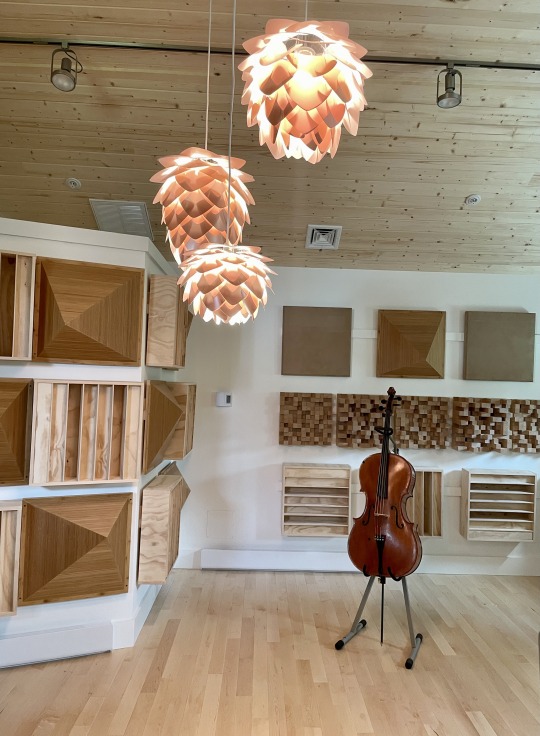
There are tiny little things to be done, bits of trim, tweaks to the acoustic treatment, furniture etc… but it is functional. The whole thing took an epic 18 months from planning, to permitting to final construction and a few weeks ago I moved in and started using it! Once my son is back to school in September I will seriously get to work in there. I have several pieces already composed for another album and recording all those fiddly little cello parts will be my first project in this new space. I can’t tell you how relieved I am to finally have a quiet, private, lovely-sounding (it does sound nice) place to create again. It’s been a few years….five, to be precise. I can no longer call this beautiful room my Cello Cave I think. It’s more of a Cello Chapel.
What else have I been up to? I spent a couple months working on the score to a science series. I don’t think I’m allowed to say much about it yet but whenever the program is ready for the world, of course I will tell you. Other things that happened in the spring: I wrote (and conducted!) a piece for a pair of ensembles for Rehearsing Philadelphia, a joint project between musicians at the Curtis Institute and Drexel. It was a fun challenge to write music for other people to play. I’m going to continue this and have a new commission from the Vermont Symphony Orchestra to write a piece for their Jukebox Quartet.
Meanwhile, I have CONCERTS. Real live in-person concerts.
Sept 16 & 17 - Burlington, VT
Nov 11 - Boston, MA
Nov 12 - NYC, NY
Nov 13 - Philadelphia, PA
Nov 14 - Alexandria, VA
Nov 18 - Minneapolis, MN
Nov 19 - Madison, WI
Nov 20 - Chicago, IL
tickets for all at http://www.zoekeating.com/perform.html
You might've heard that the calendars of mid-size venues are crowded beyond belief. At the early part of this year, a tour in November was the soonest I was able to arrange and I did my best to get this one in before Thanksgiving. West Coast, I am sorry that we weren’t able to get in any shows this year. March/April 2023 is when I hope to get out there again. Also, traveling around Europe and seeing all the modern and lovely unclassifiable artists playing at festivals - gosh I would also love to play in Europe next year too. I don’t have representation there but will cast about to try and make that happen. As always, thanks for listening.
Celloly yours, Zoë
44 notes
·
View notes
Text
What Types of Construction Training Offer The Best Learning Opportunities?
Several construction training opportunities offer the best learning experience. Learn the best ways to learn construction work.
#construction training programs in philadelphia#construction institute in philadelphia#construction trade schools degree in philadelphia#construction courses in philadelphia#construction training programs in Mantua#construction training program in philadelphia#construction programs in philadelphia#best construction institute in philadelphia#construction certification institute in philadelphia#trade schools for construction in Overbook Park#certification construction in philadelphia
0 notes
Text
Construction training and certification are essential for the success of construction workers. Dive in to understand the impact of certification on salary.
#brick courses in philadelphia#framing course in philadelphia#framing institute in philadelphia#construction trade school in philadelphia#construction classes for beginners in philadelphia#concrete technician course in Lansdowne#PA#construction trade school in Lansdowne#construction training in Lansdowne#construction program in Lansdowne#construction training programs in Lansdowne#trade schools for construction in Lansdowne
0 notes
Text
With the 2022 midterms ushering in a divided federal government, the consensus view—at least in the media—is that Washington’s moment to enact big policy measures has now passed. The New York Times, The Washington Post, The Wall Street Journal, and others predict that disputes between a Republican-led House and Democrat-led Senate will cause federal legislative work to grind to a halt. A Politico headline said it most succinctly: “Biden’s era of big government is over.”
It’s true that a divided Congress should mean a less productive and less ambitious legislative calendar. But Washington has only begun to execute all the work created by the previous Congress—and nowhere is that more true than infrastructure policy.
Between the Infrastructure Investment and Jobs Act (IIJA) and the Inflation Reduction Act (IRA), the 117th Congress invested $1.25 trillion across the transportation, energy, water resources, and broadband sectors for the next five to 10 years. It’s now the Biden administration’s responsibility to get that historic amount of money out the door—yet the bulk of it is still sitting in federal coffers or unrealized tax credits on the federal balance sheet.
Nor will implementation outside Washington be easy. Leaders in state and local governments, utilities, and qualifying industries will confront a range of challenging economic conditions to put all that federal money to work. Significant price inflation in the construction sector, the growing cost of municipal debt, a tight labor market, and a general downturn in state and local government revenues could all limit how many projects move from planning to physical construction. Communities and companies may need to right-size their infrastructure ambitions for those volatile economic realities.
The goal of this report is to use the past year of legislative activity and economic data to prepare public officials, practitioners, and analysts for what the next few years of federal infrastructure implementation may entail. If there’s one common theme across all the data, it’s this: With so much money available across so many programs, strategic implementation is now the most urgent priority. We recommend the following three cross-cutting strategies:
Rank major priorities. No matter the infrastructure sector or asset owner, there is a likelihood that not all “good” projects can be completed by the time the IIJA or IRA expire. Leaders must reconsider priorities and rank what matters most to constituents, customers, and the bottom line.
Prepare for different funding scenarios based on shifting economic conditions. Even with the significant increase in federal resources, all projects will require either matching public funding (such as formula programs), private investment (such as those incentivized by tax credits), or both. With economic conditions feeling especially volatile, practitioners should consider how different amounts of state and local dollars will impact access to federal funding. Experiences in Philadelphia and Colorado—both of which adopted policies to secure funding to make federal matches—could serve as models.
Expand the talent pipeline. The IIJA and IRA primarily fund capital investments or operations, leaving the question of where talent comes from to infrastructure owners and operators. With five to 10 years of funding increases, public and private stakeholders won’t complete their project pipeline if they don’t also address their workforce pipeline. States should make use of flexible workforce funding within the IIJA, and localities should consider new regional strategies.
2 notes
·
View notes
Text
Avenues Early Learning Centre in Shenzhen
The educators at avenues early learning centre create a warm homely atmosphere and welcome families. They believe that children learn best through strong connections with their family and the community. They also provide opportunities for family involvement and park excursions.
Students come from a wide range of backgrounds. Their parents include hedge-fund managers, entrepreneurs and tech millionaires, as well as celebrities like Suri Cruise, daughter of Tom and Katie Holmes.
Play Spaces
Designed to connect students with the natural avenues early learning centre, the Early Learning Center is located on the edge of an urban village surrounded by existing banyan trees. A bridge and elevated walkways weave through the lush canopies of these trees, creating a ‘top-of-the-world’ environment for children to explore and learn.
The concept of connections is central to the design, from physical connections in the form of bridges and walkways, to visual connections enabled by precise cuts in the existing building. The main atrium is centered in the middle of the floor plate and allows for diagonal views throughout the entire three-story building. Pods are arranged around the atrium with writable glazing that creates a fun and interactive learning surface. Thresholds and niches provide children with the duality of partial seclusion and visual connectivity, while bringing them more aware of their space and how they interact with other students.
The center is a training site for Gateway Community College students in Early Childhood Education, Human Services, Psychology, Nursing and other programs and provides a quality childcare option for Philadelphia parents. This is a unique way for students to learn about child development and apply theoretical concepts in a realworld setting.
Library
Avenues Shenzhen Campus is a re-imagined educational environment located in the Tanglang Industrial Zone of Shenzhen, an urban village in Nanshan district. The adaptive reuse master plan transforms a cluster of existing buildings into a vibrant campus for Nursery through Grade 12 and accommodates 1,600 students.
The school’s library is a gathering place for both quiet and social learning and reading. It features a collection of audio and video materials, a spacious children’s room on the second floor and a reference department, reading area and local history room on the third.
Teachers at Avenues are encouraged to build strong, nurturing relationships with the children in their care and emphasize the importance of a partnership between home and school. They are also encouraged to incorporate physical play and exercise into the curriculum, as these are key habits that help children develop a healthy body and mind. Integrated shade structures and multi-functional tiered seating are positioned on roof terraces to provide comfortable outdoor spaces.
Music & Art Lessons
A wide variety of educational activities are provided throughout the day, including sensory experiences like play dough, goop and water play. Construction with blocks, magnets and recycled items encourage divergent thinking, while art lessons and open ended exploration develop creativity and imagination.
Children are involved in medium to long term projects, which develop their knowledge and understanding of concepts through an emergent curriculum. This learning is based on the interests of the children, and often leads to social investigations.
The centre provides a warm and caring atmosphere where each child and their family feel welcome and secure. Its staff foster within each child an awareness and acceptance of others, developing respect for those who may be different in terms of lifestyle, abilities or culture. The centre also runs a number of regular incursions and visits from community services such as Henny Penny egg hatching, Dental to You and Physi Kids. The in-house chef prepares a daily menu for all age groups, which is guided by Healthy Eating Guidelines. Morning tea, lunch, afternoon tea and a late afternoon snack are provided.
Local Excursions
The Avenues pre kinder program will come from a variety of neighborhoods, and students will have the opportunity to explore different cultures in their classrooms. Students will learn the fundamental lessons of language immersion and interdisciplinary learning, laying the groundwork for lifelong benefits.
Students will be encouraged to develop healthy habits of eating and exercise during the formative years of childhood, establishing good habits for their lives as adults. Avenues faculty will also promote a healthy partnership between school and home to foster a positive learning environment for all children.
The professional onsite chef at Avenues Early Learning Centre Murarrie works closely with the management team and parents to provide a seasonal rotating menu guided by nutritional requirements. The centre regularly utilises family recipes and caters for allergies. There are a number of long term employed educators within the centres and this ensures familiar faces for children to arrive and depart with each day. The centre is rated Exceeding through the National Quality Standards.
0 notes
Text
Matt Walsh goes on a bizarre rant about minorities in the construction industry and somehow manages to be both misogynistic and racist simultaneously
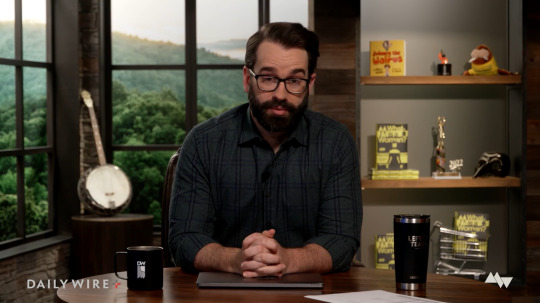
The May 8th edition of the Matt Walsh Show was absolutely stupid and infuriating, even by Matt Walsh standards. Apparently he's up in arms about female construction workers now, apparently the fact that Maine is trying to get more women involved in the construction industry is proof that white males are being systematically replaced. If this doesn't sound like bizarre white supremacist ramblings from a complete lunatic, I don't know what does. Lets get into it.
01:54, Matt Walsh: "If you've ever worked in some capacity on procuring a federal government contract than you're familiar with maybe the single most obvious and grotesque form of affirmative action that exists in this country. It's been around for a long time, as far back as Nixon's administration gender and racial affirmative action became mandatory for federal construction projects in the city of Philadelphia."
Naturally, Matt's mad that federal buildings aren't built by a team of white men and white men only. First of all, these kinds of projects aren't even that common. A majority of federal projects are things like post offices or military bases. It's a total non-issue unless you are obsessed with white people getting special treatment like Matt Walsh is.
Secondly, these rules don't just apply to race and gender. They also apply to people with disabilities and even veterans! These groups can include white males so his stupid argument falls apart even in that regard. Naturally, Matt Walsh wouldn't dedicate an entire episode of his show to how hiring veterans is an example of "woke DEI in action" or whatever because then he'd look like a dick to his audience as opposed to his usual form of looking like a dick to everyone but his audience.
Thirdly, even if those two things weren't true, who cares? People who aren't white males are allowed to have jobs in the construction sector. That is unless you're Matt Walsh and your entire point leads to the conclusion that people who aren't white males shouldn't have jobs in the construction sector or really any field because that would mean that we're being ungrateful to white men.
Just to shred the last bit of credibility Matt's argument might have, he's not even historically correct here either. The Philadelphia Plan was a short-lived federal affirmative action plan meant to address the racist hiring practices of the 1960's that lasted from 1967-1970. The bizarre thing about this episode is that Matt's seemingly trying to pretend that this is still in action. Check this out.
02:14, Matt Walsh: "And any federal contractor that hired fewer than 80 percent of the local share of quote 'any race, sex, or ethnic group' risked losing their contract and being barred from working with the federal government entirely. Within a year those requirements applied to contracts with all federal agencies nationwide. As attorney named Michael Toth pointed out recently in the Wall Street Journal, those rules are still in place today half a century later."
So Matt and this guy Michael Toth have found an obscure program from the 1960's that was basically "Hey guys, stop being racist when you hire people" that lasted for all of three years and has suddenly projected this program onto the present. I'm afraid to ask but do these guys want us to go back to what it was like in the 1960's? Oh yeah, of course they do because that's the only way to show gratitude to white males.
02:40, Matt Walsh: "Now the federal government can award no-bid contracts to so-called 'minority owned businesses' in many cases."
This isn't a bad thing, in fact it helps small businesses particularly ones that are economically disadvantaged. Supporting small businesses is something that we should all be doing and the federal government putting incentives in place to help them is an inherently good thing. What we're seeing here is absolutely naked racism.
03:07, Matt Walsh: "Now this is all highly inefficient, it's fraud basically and it's resulted in taxpayers being forced to waste a lot of money. As City Journal reported recently, some government contracts cost nearly 20% more than they would have without these affirmative action programs."
This is funny because a lot of the stuff that Matt Walsh supports such as unnecessarily high military spending and even more unnecessarily high police funding cost the taxpayers infinitely more than affirmative action in the contracting sector ever could.
03:28, Matt Walsh: "Instead of ending this social engineering and simply allowing markets to work without crude demographic manipulation, the Biden Administrations allies in state and local governments are doubling down. They've decided that they know exactly what the demographic makeup of each industry should be and it just so happens that white men aren't wanted in any industry."
This is so ridiculous. As if white men, a group that makes up %52.9 of the construction industry are underrepresented. Matt's essentially devoted this segment to giving a passionate defense for racist hiring practices based on the weak evidence of some program that lasted for three years and "muh taxes". Without these measures in place, we'd be seeing massive amounts of discrimination in the workforce.
No citations for anything he's saying by the way, just feelings and a couple opinion articles from right-wing sources as per usual.
03:51, Matt Walsh: "So I'll start with Maine where this week Democrats have determined that the field of construction, where blacks and hispanics make up nearly 40 percent of the workforce, simply isn't diverse enough somehow. Specifically the governor, Janet Mills, has determined that more women need to be construction workers and therefor Mills has signed an executive order that among other things will use state and federal funding to prioritize construction projects that involve women."
Essentially, this executive order is designed to help women enter the construction industry. This is mainly due to Maine experiencing a shortage of construction workers, something which Matt never acknowledges. Some of the things that it puts in place are the pursuit of grant opportunities to incentivize hiring women in construction and connecting businesses with women studying in the trades.
This is one of the least offensive bills on Earth. It's completely innocent and is really more of a push to help the construction shortage if anything. Matt is really raging about this though.
05:00, Matt Walsh: "We need construction workers, especially women now. Why? Why especially women? And this is odd coming from Janet Mills who spent her college years travelling through Europe and learning French before going into law school and spending the rest of her life in government. What does Janet Mills know about construction exactly?"
This is such a stupid argument. If people in congress could only pass legislation on exactly what they studied in college we'd get absolutely nothing done. Lets think about what the world would look like if Matt's argument had any bearing on it for a second. For starters, we can kiss NASA goodbye because I can't think of any congresspeople who studied aerospace engineering. What do they know about rocket science? No more vaccination programs or bills dedicated to combating cancer, these congresspeople know nothing of immunology and research on cancer.
I don't know if Matt knows this, I hope he does because he's a grown man, but people in government consult experts. Lets flip this around too. Matt's a high school graduate. Lets kick him off the Daily Wire because he has no qualifications.
05:24, Matt Walsh: "Now as always this DEI initiative is a solution in search of a problem."
Except that Maine is going through a construction worker shortage you dimwit. This is absolutely horrendous journalistic work even by Matt's standards. I propose that Matt learns the journalistic practices of "doing a twelve second Google search" and "actually reading about the thing that you're talking about so that you don't look like a stupid dipshit".
06:01, Matt Walsh: "By all accounts, fewer women are in construction for two simple reasons. First, because most women don't want to do construction and second because men are generally much better at it."
Citation needed. Matt never really backs up any of the stuff he's saying with legitimate evidence. I guess he just has a mental link with every woman in America which is how he knows that "most women don't want to do construction". That must come as a shock to the 1,173,000 women currently employed in the construction industry in the United States.
07:29, Matt Walsh: "Men tend to do most of the physically demanding and dangerous jobs everywhere. This is not a privilege that men have but rather a responsibility that they have carried. The takeaway from this shouldn't be that we need more women doing these jobs, it's that men and white men in particular historically, have had a unique and essential role in building and maintaining our civilization."
So, Matt's putting his misogyny and racism eggs in one basket here. Matt literally just admitted that 40 percent of the construction workforce consists of Hispanic and African American workers. Even historically Matt's completely incorrect due to the fact that a majority of our civilization historically was built using the horrific practice of slavery.
What exactly has Matt Walsh contributed to the world by the way? Really stupid easily debunkable commentary that's presentable enough to con people into believing it's gospel.
"Yeah, I'm not saying that I, Matt Walsh, am a hero. BUT civilization was built by white men just like myself so maybe show a little gratitude."
08:01, Matt Walsh: "So rather than this constant drum beat of scolding and lecturing and guilt and resentment, treating the presence of this group as a problem that must be solved that must be solved or a cancer that must be treated, the appropriate attitude is one of appreciation and gratitude."
This must be one of the greatest examples of acting oppressed over nothing in the history of humanity. Matt's essentially saying that he's mad that people are pointing out historical atrocities carried out by white males, such as the aforementioned slavery, and instead wants people to just kiss his ass for the rest of time. It's such a childish attitude to have.
08:18, Matt Walsh: "Men built every building you've ever been in, every bridge you've ever crossed, every road you've ever driven on."
More broad sweeping generalizations. Also, I find it so insane that he doesn't recognize that maybe that's because men have prevented women from building bridges, buildings, and roads. Keep in mind that this is still about legislation designed to address a construction shortage, something which he still hasn't acknowledged. He's acting as if men are being kicked out of construction in Maine which is a bald-faced lie.
09:05, Matt Walsh: "And this same logic applies to race as well, I mean these days of course as noted it's not just white men in the construction industry but historically speaking white men have been uniquely indispensable contributors to western civilization."
Yeah, because white men historically speaking didn't allow anyone of other races and creeds to contribute. I can't believe that this is an adult. Plus, people of other races and sexualities and genders have made massive contributions to our civilization. This is historically ignorant at best and borderline white supremacist at best.
09:48, Matt Walsh: "A sane society would be finding ways to get this group more involved in things given it's incredible track record of success, instead we go the other way."
Did I say borderline white supremacist? Yeah, I meant barely dog-whistling anymore pure unfiltered white supremacist. What Matt is essentially saying here is that white males are inherently superior to every other race and gender just by virtue of being white men. This is mask off for even the Daily Wire.
10:22, Matt Walsh: "It's also happening in the most populated city in the United States. Officials in New York have just proudly announced that they've awarded more than 2 billion dollars in contracts for the purpose of renovating JFK Airport and all of that money has gone to so called MWBE's which is short for minority and women owned business enterprises."
So, supporting small businesses in a region of NYC that's primarily made up of minorities. Got it. Is this the part where I'm supposed to be horrified that they're not just giving all the contracts to whites?
Alright, I'm tired of this segment so for the sake of my sanity lets look at some of the other more humorous stupid crap that Matt Walsh is peddling. We go to Matt's May 7th show where he's attempting to do a little bit of media criticism.
00:00, Matt Walsh: "Well it seems that Star Wars has gone woke, again, for approximately the ten thousandth time Star Wars has been used as a vehicle to push a radical left-wing agenda."
"A radical left-wing agenda", sounds serious. Clearly this is some really serious business that justifies stating that a piece of media pushes a radical left-wing agenda (as someone who works at a right-wing media company by the way, rules for thee and all that).
00:11, Matt Walsh: "A new animated Star Wars television series features a nonbinary Jedi who is nonbinary (sic) with other characters referring to this Jedi as 'them'."
Some character in a TV Show uses they/them pronouns, this is what you're concerning yourself with you complete and utter dimwit?! Dude, Star Wars takes place on a different planet. If any franchise should incorporate nonbinary characters it's Star Wars. Like, how can you look at Chewbacca and Jabba the Hut and go "Yeah, these characters fit into a male/female human gender binary". That aside, who cares? This is such a nonissue that it's not even funny.
By the way, Matt's struggling a little here because it looks like his team forgot to switch out the headline on screen from one displayed in a different segment. Brilliant work.
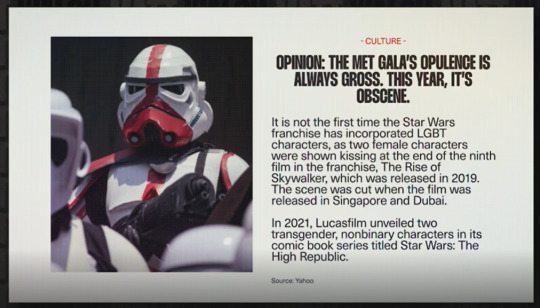
01:51, Matt Walsh: "In any event, you know I find this line to be pretty funny. She says 'Let them die'. She doesn't care if the nonbinary Jedi dies and yet even as she expresses that level of disdain she still makes sure to respect the pronouns."
Yeah, it's a cartoon Matt. I feel like you might be reading a little too into this all things considered.
Conclusion:
Well that was certainly.....something all right. Like I've said all along on this blog, if anyone displays this level of concern around the "white race" you should really run. Between Matt Walsh and Charlie Kirk it's been a pretty mask off couple of weeks for right-wing media fearmongering about race. Cheers and I'll see you in the next one.
Original Videos:
“Ep. 1364 - White Men Deserve Gratitude, Not Demonization.” The Daily Wire
“And yet Another Reason Not to Watch Star Wars.” Rumble.com.
Sources:
“Project Type: Is the Construction Project Private, Public, or Federal?” NCS Credit, 15 Mar. 2021.
U.S. Department of Labor. “Affirmative Action | U.S. Department of Labor.” Dol.gov, 2019.
David Hamilton Golland. “The Philadelphia Plan (1967-1970) •.” Blackpast.org, 26 May 2014.
“Governor Mills Signs Executive Order to Increase Women’s Employment in Maine’s Construction Industry | Office of Governor Janet T. Mills.” Www.maine.gov, 6 May 2024.
Whittle, Patrick. “Maine Has a Workforce Shortage Problem That It Hopes to Resolve with Recently Arrived Immigrants.” AP News, 19 Jan. 2024.
#right wing bullshit#journalism#fact checking#conservative bullshit#bad takes#disinformation#conservatives#politics#debunking#daily wire#matt walsh#fuck maga
0 notes
Link
0 notes